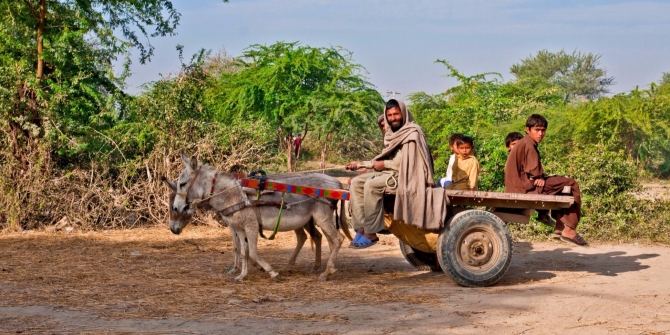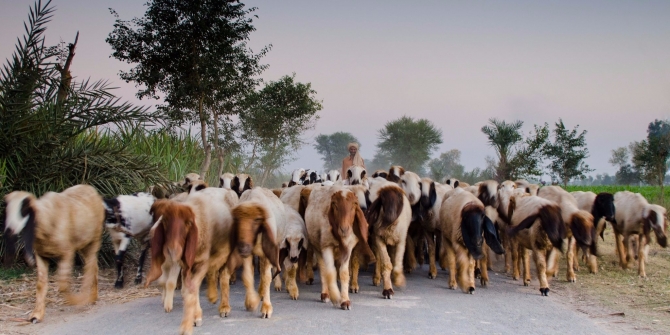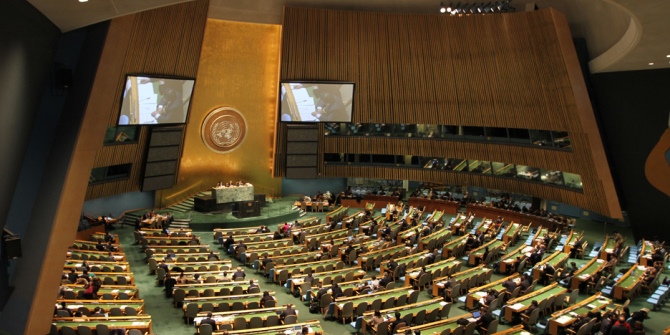 With a small travel grant, many landless rural workers in Pakistan can temporarily migrate and benefit from work opportunities in cities writes Agha Ali Akram. Based on his research, he points to this new and cost-effective policy option to improve rural welfare and address the terrible suffering caused by seasonal deprivation.
With a small travel grant, many landless rural workers in Pakistan can temporarily migrate and benefit from work opportunities in cities writes Agha Ali Akram. Based on his research, he points to this new and cost-effective policy option to improve rural welfare and address the terrible suffering caused by seasonal deprivation.
According to conservative estimates half of the world’s 600 million food insecure people who live in rural areas suffer from seasonal hunger during the “lean season”, the period of the agricultural cycle between planting and harvest when there is less work. As much as 50 percent of Pakistan’s population is food insecure, and while there are no specific estimates, it is likely that Pakistan’s large agriculture sector – which employs 45 percent of its workforce – is vulnerable to seasonal deprivation.
Could offering residents of rural areas a small travel grant to temporarily migrate alleviate their suffering? In a recent study Mushfiq Mobarak (Yale University), Shyamal Chowdhury (University of Sydney), and I conducted in Bangladesh, we show that travel grants targeting the landless improve their own welfare and benefit rural village economies in the midst of seasonal deprivation.
Seasonal food insecurity in Rangpur and a potential solution
Every year, September ushers in a three-month lean season for landless farmers living in Rangpur, a region in the northwest of Bangladesh. Agricultural work dries up and the landless lose their source of income. And since they do not own property, they are unable to grow enough of their own food. This sets off a period of considerable hardship.
Small travel grants to temporarily leave the region and find work in nearby urban areas that are not affected by the lean season show promise as a solution. Gharad Bryan and my co-authors previously tested this idea and found that grantees increased both consumption and caloric intake. They also migrated during the subsequent lean season without being offered a travel grant. The small travel grant reduced the risk households associated with temporary migration and opened a highly profitable opportunity for them.
Studying spillovers: What we did differently
Given these results, we wondered if the consequences of temporary migration were “spilling over” to villages of origin. For instance, migration might create a relative scarcity of labor for village employers, driving up local wages and benefiting landless workers who stay back. Conversely, if non-migrants and migrants have a complimentary relationship – that is, non-migrants depend on migrants to find work – then migration would hurt the rural economy as non-migrant productivity would drop.
To measure these potential spillovers, we built on Bryan et. al in our own study by varying the amount of travel grants offered to landless workers. In 47 “high-intensity” villages, we offered 70 percent of landless residents a grant, while in 48 “low-intensity” villages we offered 14 percent of landless residents a grant (for a total of 5,792 offers made across the two treatment groups). 38 other villages were assigned to a control group, in which no one was offered a grant.

This variation in the intensity of travel grant offers allowed us to understand the spillovers of migration. The higher the migration rate, the greater the potential impacts on the local village economy.
The travel grant scheme was coupled with extensive surveys. We surveyed both households that were offered the grant and those that were not offered. Surveying households that were not offered allowed us to detect whether a migration opportunity they could not access benefitted them nonetheless. We also surveyed employers in all our villages to understand wage and other demand-side impacts. Finally, we repeated the household and employer surveys in the subsequent lean season. Our surveys sampled 3,600 households and 1,099 employers across control and treatment villages.
The results
First, we find that grantees were much more likely to migrate and find work in nearby cities. Due to this increase, migrants in the high-intensity group increased their total income by 20 percent from working in destination cities.
Next, more strikingly, we find that those offered the travel grant in high-intensity villages were twice as likely to migrate than those in low-intensity villages, suggesting that people are more likely to migrate if more people around them are also likely to migrate. In fact, we also find that landless workers not offered the grant were more likely to migrate in high-intensity villages, which suggests that just knowing people who are likely to migrate can increase one’s own likelihood of migrating without needing any subsidization. This is important. A programme built around a travel grant like ours could save costs because not everyone needs to be subsidized.
Moreover, under the assumption that rural labor markets are not well integrated (i.e. the village is the relevant labor market), we also find that the local agricultural wage rate increases. In our high-intensity villages, more than half of the local landless population migrate away because of the travel grant we offer, “emptying out” the local labor market. This bids the origin village wage rate up, as reported by employers in our survey work, since there is relative labor scarcity.
Migrant workers take advantage of this increased wage rate by supplying more labor in the origin village labor market too. They do this by migrating back and forth between their origin village and destination over the course of the lean season. Because so many people do this, there is slack in the village labor market that landless workers can take advantage of. Where previously village labor markets had few opportunities for paid work, there were now relatively more opportunities available. This is good news for landless workers as they can take advantage of opportunities both in the city to which they temporarily migrate and their own village.

Policy implications and the bigger picture
Our results point to a new and cost-effective policy option to improve rural welfare and address the terrible suffering caused by seasonal deprivation. With a small travel grant, many landless rural workers can temporarily migrate and benefit from work opportunities in cities. A key insight from our study is that a seasonal migration grant policy at scale would potentially benefit the rural economy since it bids up the local agricultural wage and allows previously unemployed workers to find opportunities. And any programme that uses travel grants would not need to be offered to all landless workers because those not offered a grant also migrate, suggesting that there is an optimal level of coverage below 100 percent.
Additionally, our findings point the way to a policy that can complement existing rural development programmes. Typically, rural development policy efforts focus on developing human and physical capital by providing very direct financial and material support to the rural sector through rural support programmes (Pakistan has at least 11 major rural support programmes). The seasonal migration travel grant provides an innovative and scalable solution to add to the existing set of rural support programmes. In fact, rural support programmes provide a natural vehicle to scale the travel grant, adding it to their programming.
Finally, the travel grant has potential for impact if applied to other kinds deprivation. For example, the deaths, water shortages, and loss of livelihood brought on by seasonal drought in Pakistan’s Thar region could be ameliorated if residents had access to a travel grant. Given the inherent unpredictability of disasters, mobilizing resources could be challenging but is well within the realm of possibility.
This article was first published in the Pakistan’s Growth Story, and is republished with permission. This article gives the views of the author, and not the position of the South Asia @ LSE blog, nor of the London School of Economics. Please read our comments policy before posting.
About The Author
 Agha Ali Akram is an environmental economist who recently completed a fellowship at Yale University’s School of Forestry and Environmental Studies. He holds a PhD in Environmental Economics from Yale University.
Agha Ali Akram is an environmental economist who recently completed a fellowship at Yale University’s School of Forestry and Environmental Studies. He holds a PhD in Environmental Economics from Yale University.







